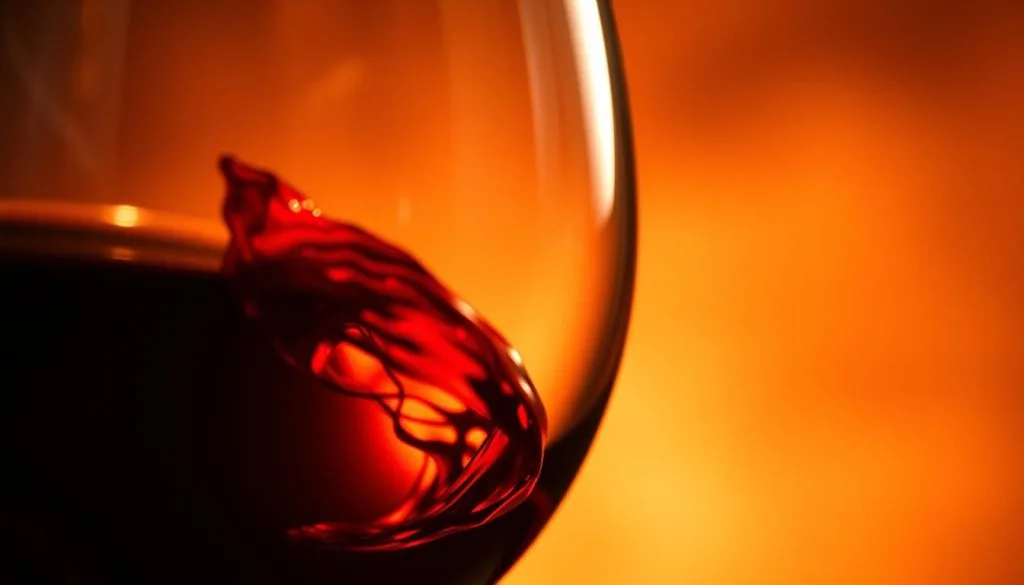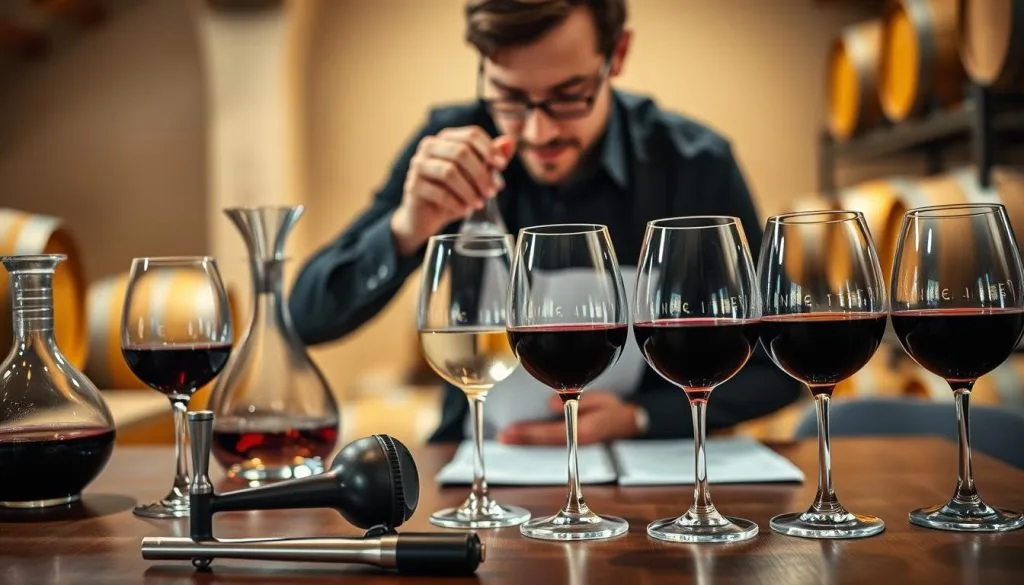This post may contains affiliate links. Read our full disclosure here.
Ever wondered why a swirl of cabernet smells like crushed blueberries or how chardonnay whispers vanilla? It’s not wizardry—it’s science in a stemless glass. Every fragrant note, from zesty citrus to smoky oak, comes from invisible molecules dancing through fermentation and aging.
Take esters—those playful compounds that bring fruity bursts of apple or peach. Or thiols, which swing between garlicky funk and tropical vibes. Even that peppery kick in your syrah? Thank rotundone, a compound so potent it’s detectable at three parts per billion. Think of it like a perfume lab meets a Michelin-star kitchen.
Modern winemakers now play mad scientist, manipulating these compounds through yeast strains and barrel choices. Want lychee notes in your riesling? Terpenes have your back. Craving that campfire smokiness? Maillard reactions work overtime during aging.
This isn’t just about fancy descriptors at wine tastings. It’s chemistry rewriting how we experience luxury—one aromatic molecule at a time. Next time you nose a glass, remember: you’re not just smelling wine. You’re breathing in a billion-dollar blend of nature and human ingenuity.
Introduction to Wine Aromas and Their Science
Imagine your favorite playlist—each song’s vibe shaped by hidden basslines and synth layers. Wine aromas work similarly: invisible molecules orchestrate symphonies of flavor that hit your senses like a Drake chorus. These volatile compounds—esters, thiols, terpenes—aren’t just fancy terms. They’re the DNA of every sniff and sip.
Defining the Invisible Players
Aroma isn’t poetry—it’s chemistry in motion. When yeast feasts on grape sugars during fermentation, it pumps out compounds like isoamyl acetate (think banana Runts) and β-damascenone (hello, rose petals). Acids act as backstage crew, stabilizing these molecules so they survive bottling. As Master Sommelier Victoria James notes:
“What you smell is the wine’s résumé—every vintage and vineyard decision printed in aromatic ink.”
Nose vs. Palate: The Flavor Tango
Here’s the twist: aroma is the scent rising from your glass, while flavor blends taste + retro-nasal smell. Research from aromatic science studies shows 80% of perceived flavor actually comes from smell. That’s why pinot noir can taste like cherries… even though it’s just fermented grapes.
| Aroma Source | Common Notes | Key Compound |
|---|---|---|
| Primary (Grapes) | Citrus, Herbs | Terpenes |
| Secondary (Fermentation) | Butter, Bread | Diacetyl |
| Tertiary (Aging) | Vanilla, Smoke | Oak Lactones |
Urban myth? Swirling your glass isn’t pretentious—it aerates the wine, releasing trapped aromas like opening a Spotify EQ slider. Next time you taste, ask: Is that lychee note from the yeast strain… or the winemaker’s wild experiment?
The Chemical Compounds That Create Wine Aromas
Picture this: your glass of cabernet sauvignon isn’t just fermented grapes—it’s a molecular art gallery. Three chemical rockstars steal the show. Esters bring the pop hits (think pineapple in grenache), terpenes drop floral mixtapes (hello, riesling’s lychee vibes), while thiols switch between jalapeño heat and passionfruit sweetness.

Understanding Esters, Terpenes, and Thiols
Esters are fermentation’s party favors—volatile compounds that vanish faster than TikTok trends. They’re why your chardonnay smells like baked apple fritters at first sip. But crank up the acidity, and they’ll outlast a Beyoncé concert. Studies show concentrations from 50 μg/L to 5 mg/L decide whether you get whispers or shouts of peach.
Thiols play Jekyll and Hyde. In sauvignon blanc, 3-mercaptohexanol (1.5 ng/L!) screams guava. But let oxygen crash the party? Suddenly it’s canned asparagus city. As one enologist quips:
“Thiols are the divas of wine chemistry—brilliant but temperamental.”
The Role of Yeast, Acids, and Fermentation Processes
Yeast strains are the ultimate hype crew. Pick Saccharomyces cerevisiae XXII, and your wine bursts with isoamyl acetate (banana vibes). Go wild with native yeasts? Expect earthy funk that’d make a sourdough starter jealous. Acids act like bouncers—locking aromas in place so they survive bottling to glass.
Fermentation temperature matters more than your Spotify Wrapped. Cool temps (12°C) preserve delicate esters for whites. Reds cranked to 30°C? That’s how cabernet gets its cassis swagger. It’s science with a side of chaos theory—every decision writes a new aromatic verse.
How-To Guide: Identifying and Analyzing Wine Aroma Compounds
Think of wine tasting like decoding a Netflix thriller—every sniff holds clues. Master Sommelier Vanessa Conlin calls it “CSI: Cabernet Edition,” where your senses become forensic tools. Whether you’re swiping right on a juicy pinot or ghosting a flabby chardonnay, these techniques turn novices into flavor detectives.

Practical Tasting Techniques for Beginners
Step 1: Gear Up Like a Pro. Use stemmed glasses—they’re the AirPods Max of wine tools, preventing heat transfer. Swirl clockwise to aerate; this isn’t a TikTok dance move but a way to unleash trapped aromas. Step 2: Sniff Strategically. Divide scents into three acts: fruit (citrus, blackberry), earth (wet stone, mushroom), and drama (vanilla, smoke). As podcast Wine for Normal People advises:
“Your first impression is the trailer—the full story unfolds sip by sip.”
Interpreting Sensory Notes During Blind Tasting
Spot lychee in riesling? That’s terpenes flexing. Butter in chardonnay? Diacetyl doing heavy lifting. Create a mental Spotify playlist: tropical fruits = thiols (sauvignon blanc), pepper = rotundone (syrah). If your wine smells like a high school chemistry lab, ethyl acetate might be crashing the party.
Blind tasting is less about “guessing the grape” and more about pattern recognition. Jot notes like you’re DMing a friend: “Vibes: burnt caramel, overripe peach, and that candle Aunt Karen loves.” Over time, you’ll decode how vineyard decisions—like oak aging or wild yeast—print their résumés in every glass.
Key Processes Impacting Wine Aroma Development
Think of crafting aromatic complexity like a relay race—each stage passes the baton to build depth. Three powerhouse processes act as sprinters: microbial magic during fermentation, oak’s slow whisper during aging, and biotech’s precision engineering.

Fermentation: Yeast’s Greatest Hits Album
Microbes are the ultimate DJs here. Saccharomyces yeast pumps out esters (peach! pineapple!) while lactic acid bacteria add buttered popcorn vibes via diacetyl. But let Brettanomyces crash the party? You’ll get barnyard funk—a divisive feature in natural wines. Temperature matters: cool ferments (12°C) preserve delicate notes, while heat (30°C) amplifies boozy intensity.
Oak’s Flavor Bootcamp
Aging in barrels isn’t just storage—it’s flavor bootcamp. American oak delivers vanilla extract levels of lactones, while French oak whispers baking spices. Toasted barrels? That’s where smoke and caramel enter the chat. As sommelier Doreen Winkler notes:
“Oak is the bassline—felt more than heard, but essential for harmony.”
Biotech’s Upgrade Culture
Modern labs now code aroma like software updates. Enzymes like glycosidases unlock bound terpenes (hello, floral riesling), while engineered yeast strains bypass unwanted alcohol heat. Some winemakers even use CRISPR-edited microbes to delete off-notes—think of it as biohacking for your glass.
| Process | Aroma Boost | Science Hack |
|---|---|---|
| Fermentation | Fruit bombs, butter | Yeast strain selection |
| Oak Aging | Vanilla, smoke | Toast level customization |
| Biotech | Lychee, rose | Enzyme-triggered releases |
Factors Influencing Wine Aroma Complexity
Vineyards are nature’s mood boards—every grape cluster a bespoke blend of sunlight, dirt, and microbe magic. What separates a basic pinot from a cult-worthy bottle? It’s not just winemaker genius. The real drama unfolds in the dirt.
Grape Varieties: Nature’s Blueprint
Think of Vitis vinifera as fashion houses—each variety has its signature style. Sauvignon blanc struts with cat pee sass (thank methoxypyrazines), while Gewürztraminer drips in lychee couture via terpenes. A UC Davis study found Cabernet Franc grown in limestone soils amps green pepper notes by 40% compared to clay-heavy plots.
Dirt, Climate, and Controlled Chaos
Soil isn’t just dirt—it’s a flavor lab. Volcanic ash in Oregon’s Willamette Valley? That’s why their pinot noirs taste like smoked cherries. Napa’s gravelly loam? It’s the secret behind cabernet’s cassis swagger. Water stress plays villain too: controlled droughts boost phenolic compounds, turning up jammy vibes like a Spotify bass boost.
“A vineyard’s ZIP code writes the first draft of every wine’s personality.”
| Factor | Vibe Shift | Example |
|---|---|---|
| Cool Climate | Razor-sharp acidity | Chablis’ wet stone minerality |
| Volcanic Soil | Smoky intensity | Etna Rosso’s burnt orange notes |
| Water Deficit | Concentrated fruit | Barossa Shiraz’s plum bomb |
Modern wine lovers aren’t just buying bottles—they’re collecting liquid real estate. That “Bordeaux funk” or Sonoma Coast salinity? It’s terroir’s autograph, inked through centuries of geological drama. Next time you swirl, remember: every sip is a backstage pass to nature’s greatest show.
Conclusion
Consider wine your liquid passport—a profile stamped with volcanic soil whispers, oak’s smoky fingerprints, and yeast’s secret handshakes. From Cabernet Sauvignon’s green pepper swagger to Sauvignon Blanc’s tropical punch, every bottle is a lab experiment served in stemware.
Esters and thiols aren’t just science jargon—they’re the architects of that first-sip dopamine hit. Acids stabilize these volatile substances, while oak aging layers vanilla like a cashmere throw. Fermentation? That’s where grapes transform into liquid couture.
Urban myth: tasting notes are for snobs. Truth? Swirling your glass is decoding terroir’s DNA. Spot lychee in riesling? Thank terpenes. Crave buttered toast in chardonnay? Diacetyl’s backstage pass. Your palate’s the ultimate mood board.
So next time you uncork, play mad scientist. Test techniques: aerate aggressively, sniff skeptically. Let chemistry rewrite your wine IQ—one aromatic Easter egg at a time. Ready to level up? The vineyard’s secrets await. Swirl, sip, repeat.




